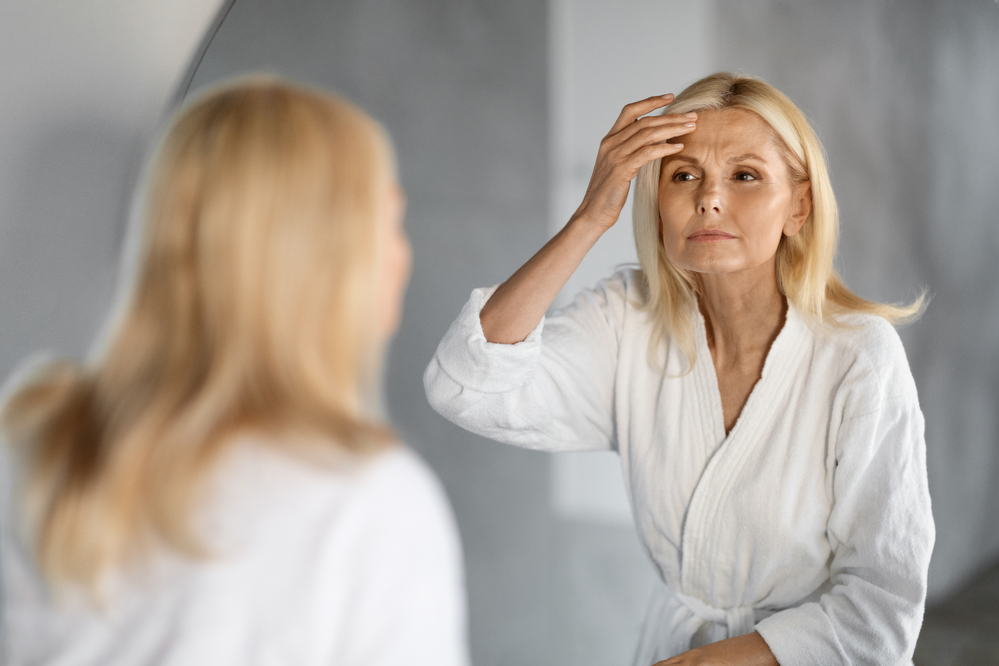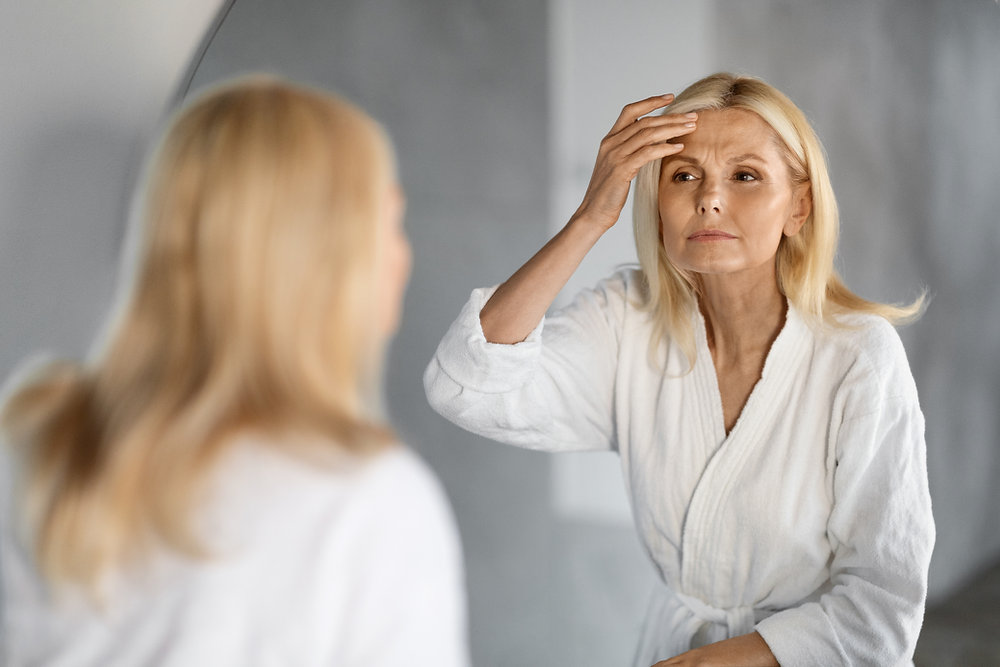
Hyperpigmentation is a common skin condition that makes some areas of the skin darker than others. But fading dark spots is tricky! To make progress you need to remain diligent. The trick is to be patient: It can take 8–12 weeks of daily use until you see significant results. Then when a sun situation comes along you might be back to square one.The main pigment in your skin is called melanin. Uneven distribution of melanin can create spots or patches that appear brown, black, gray, red or pink. These areas are not painful or itchy but they can make you look tired and feel self-conscious. They are sometimes called age spots, sun spots or liver spots, and yes they’re hard to get rid of. However, with lifestyle changes and dedication to treatments you can make a fair amount of progress. Consistent sun protection and appropriate skincare will make all the difference.Types of Uneven PigmentationAge Spots (medically referred to as solar lentigines)
Age spots, liver spots and sun spots are the same thing. They are a common form of discoloration that appear as small, flat, darkened patches of skin that are light brown to black in color. They tend to show up more frequently later in life. That’s because as estrogen wains sun damage that may have occurred years ago suddenly shows up. Discolorations are most common in people over the age of 40 (hence the name age spots), even more likely to appear after menopause. Melanin acts as your skin’s natural sunscreen by protecting you from harmful UV rays, which is why people tan in the sun. Excessive sun exposure increases DNA damage to melanocytes (the pigment producing cells) which then affects the amount of melanin produced in damaged areas. As the name suggests “sunspots” are dark spots most commonly triggered by over-exposure to the sun. For this reason, they’re usually found on areas of the body that are frequently in the sun like: face, neck, décolleté, shoulders, forearms and hands.
Post Inflammatory Hyperpigmentation (PIH)
Post-inflammatory hyperpigmentation (PIH) happens when your skin makes extra melanin after it has been irritated or injured. It’s the term for skin discolorations that linger after an acne blemish has healed. Other traumas like eczema, a rash, or a cut can also cause PIH. PIH can affect either your epidermis (which is your skin’s surface layer) or your dermis (which is the deeper layer). Dermal PIH is much harder to treat. PIE is Post-Inflammatory Erythema. It differs from post-inflammatory hyperpigmentation because of the color: PIE is pink to red, while PIH can be tan, brown, or grayish looking.
Melasma
Melasma is a skin condition characterized by brown or blue-gray patches or freckle-like spots. It’s often called the “mask of pregnancy” because of its location spread across the face. Melasma is genetic and connected with increased estrogen production plus sun or heat exposure. It happens because of an overproduction of the cells (melanocytes) that make the color of your skin. It is common and harmless but annoying, consistent treatment can help. Melasma usually fades after a few months.
Freckles
I think they’re cute… so stop fretting about them.How can I prevent Uneven Skin Tone?Discoloration and uneven pigmentation can’t always be prevented, but protecting your skin from the sun is the first step:Apply sunscreen every day!
UV light can sneak past clouds and go through windows, and UVA light is just as potent in winter as it is in summer. Choose a sunscreen that’s “broad spectrum” (blocks ultraviolet rays from both UVA and UVB). Make sure it has a SPF of 30 or higher. A physical sunblock based on titanium dioxide or zinc oxide is good if you have sensitive skin that gets red easily. They work by creating a “wall” that blocks out the sun (to a certain extent). Chemical sunscreens work by changing ultraviolet rays into heat, which is then released by the skin. This can cause sensitivity for some. I prefer a chemical sunscreen with a SPF of 50. I like it because it’s more cosmetically appealing (more fluid, easier to spread, and more like a moisturizer). The one I use also contains skin brighteners that interfere with that whole pigmentation production process. And. I like it because it acts as my morning moisturizer.
Avoid too much sun exposure.
No sense of false security here. Remember that sunscreen does not block out all of the damaging effects of the sun no matter how good you are at applying and reapplying it.
Stay cool.
Past sun damage may be hiding under your skin cells. Heat can trigger that pigment to rise up to the skin’s surface when you’re hot. Thus, becoming more visible. This is why clients sometimes complain that they still get pigmentation even though they’ve vowed to wear sunscreen every day.
Wear protective clothing
and hats and sunglasses along with your broad-spectrum sunscreen with an SPF 50. Look, every little bit helps. And, there are some great brands of UPF clothing you can find online.
SKIN BRIGHTENING REQUIRES A MULTIFACETED EFFORT TO GET RESULTSUse a Vitamin C Ester Daily.
Even before UV damage starts to appear you want to nip it in the bud… before it becomes a problem. To discourage the accumulated damage, daily application of a Vitamin C serum is a great tool. As a tyrosinase inhibitor, Vitamin C serums interfere with melanin production. Look for an ester version which is more stable and less irritating than l-ascorbic acid. This is important because irritated skin is more prone to pigmentatiion. With ongoing use clients report their skin stays fresher and more even toned.
Gently exfoliate with skin acids.
Again, be gentle. Regular use of AHAs will slough away the darker surface cells. Check your skin type to discover which acids and exfoliants are best for your skin. You may find chemical exfoliants are easier on your skin than scrubs, especially avoid those with rough edges, like walnuts or almond husks. Azelaic Acid has a special affinity for brightening the skin.
Retinoids.
Retinoids have a plethora of science behind them regarding skin brightening. Retinoids encourage the production of newer, fresher, and clearer cells. Whether you choose retinol, retinaldehyde or retinoic acid keep it below the level of inflammation. Feels uncomfortable? Dial it back. Your skin will respond better with a gentler approach.
Be patient.
When you decide to adopt a skin brightening program it will take time for appreciable changes in your skin. Then, if you go out in the sun again you might re-pigment your skin all over again. You should also include several brighteners for their synergistic approach.
Antioxidants and tyrosinase inhibitors.
Chemicals derived from plant extracts are soothing and protective for your skin’s longevity – while interfering with the production of unwanted pigment. A variety of these tyrosinase inhibitors (like green tea and licorice root) are recommended because many of these work via different pathways to brighten your skin.
A COMPLETE PROGRAM FOR TREATING UNEVEN PIGMENTATIONC & E Antioxidant Serum
Vitamin C is exceptionally effective at inhibiting the activity of the tyrosinase enzyme, thus reducing areas of hyperpigmentation and creating a more even skin tone. Use it proactively every morning followed by SPF to keep pigmentation at bay. Along with interfering with new melanin, this antioxidant helps neutralize free radicals for skin longevity and contributes to a better efficacy for your sunscreen. Brighten Up Dark Spot Corrector
This amazing new spot treatment features Tranexamic Acid. It’s targeted to brighten your skin as it reduces dark spots. It does this by interfering with melanin production and blocking the interaction between melanocytes and keratinocytes. It’s also great at blocking melanin that contributes to melasma. Brighten Up is part of a powerful skin lightening duo. It works best when used twice a day on dark spots. Follow up with Illuminate, our glow enhancing hydration cream.
Brightening Day Protection 50 SPF
Natural antioxidant botanicals – are wonderfully calming and contribute to the brightening effects in your skincare products, including sunscreen. Ours feature Water Lily Extract, Licorice Root Extract and Yeast Proteins. These hard-working antioxidants brighten, soothe and protect skin from environmental aggressors. This ensures your broad spectrum sunscreen is doing more to protect your skin than just SPF alone. First Light Therapy
At night the right exfoliating acid is helpful for removing old pigmented cells. It is preferred over physical exfoliants because the abrasion from scrubs may activate inflammation which can lead to increased pigmentation. Azelaic Acid is a gentle exfoliant that has antibacterial and anti-inflammatory effects, and is especially good for brightening. It’s good even for sensitive and rosacea prone skin. Beyond exfoliation, Azelaic Acid helps even out skin tone by stopping free radicals and toxins that damage your skin.
First Light Lotion
Niacinamide is one of the most effective ingredients as part of the combination therapy required for skin brightening. This lotion works well for oily or combination skins. Niacinamide is a key ingredient for brightening. Besides promoting hydration and improved barrier function, it inhibits pigment transfer between cells reducing dark spots & discoloration. You’ll also find niacinamide in AGELESS peptide serum and ILLUMINATE glow enhancing hydration. When focusing on brightening this light weight, glow enhancing hydration cream covers all your bases as part of a comprehensive skin brightening program. We’ve created an effective pigmentation reducing hydration cream employing high performance brightening ingredients which includes the right percent of niacinamide +Alpha-Arbutin – another powerful brightener to reduce dark spots and improve skin texture. Resorcinol – Which has been shown to be as effective as 2% hydroquinone (without the safety issues).
Are you ready for brighter skin? Choose your weapons.Elizabeth believes in “Longevity Skincare”, the idea that beautiful skin can endure throughout one’s lifetime when utilizing the best that science and nature has to offer. LONGEVITY is a science – based skincare line that appreciates skin of all ages. LONGEVITY by Elizabeth Renee provides hydration, nutrition and protection from environmental aging. Your skin will receive high performance ingredients to help energize and repair its cells, resulting in a healthy skin with an enduring, vital glow.
